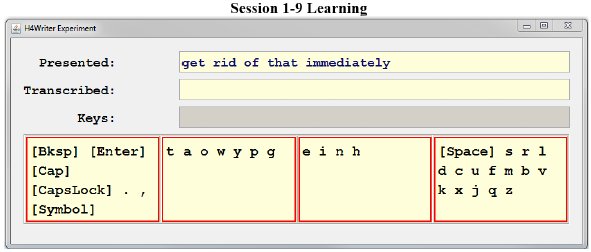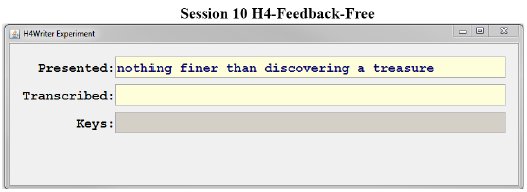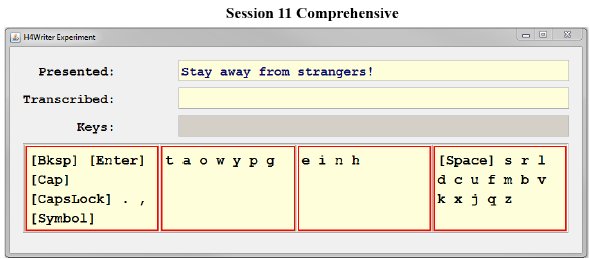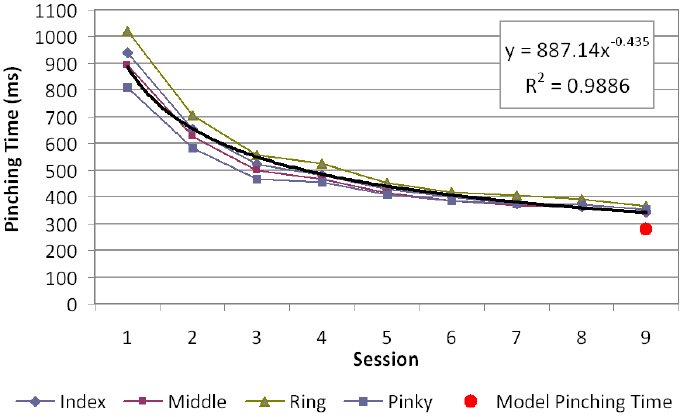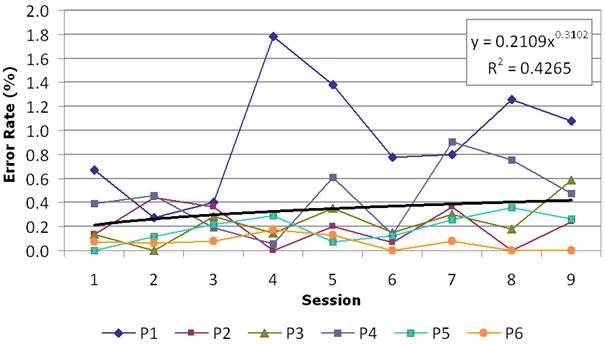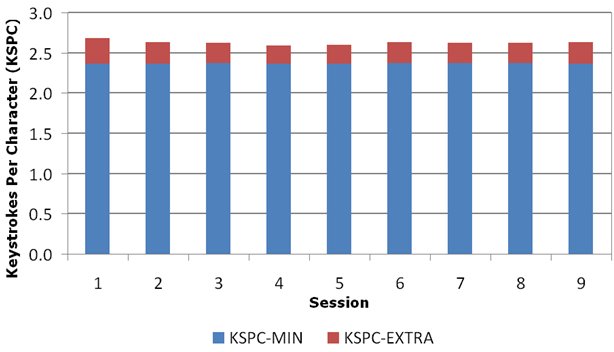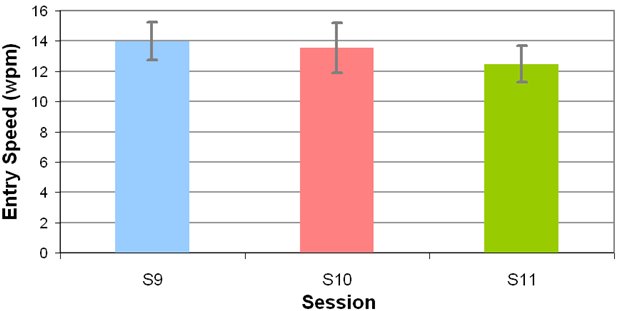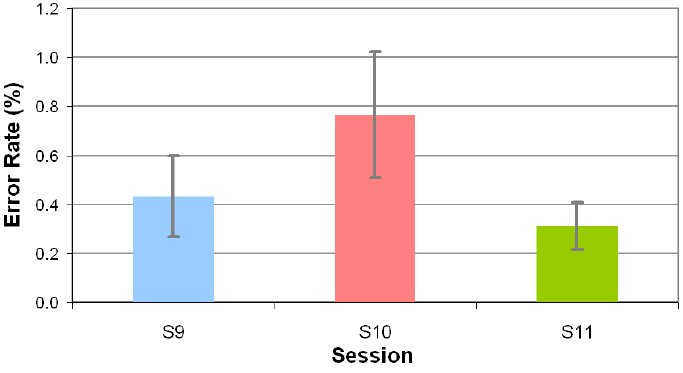Bajer, B., MacKenzie, I. S., & Baljko, B. (2012). Huffman base-4 text entry glove (H4-TEG). Proceedings of the International Symposium on Wearable Computing - ISWC 2012, 41-47. New York: IEEE. [PDF] [video]
Huffman Base-4 Text Entry Glove (H4-TEG)
Bartosz Bajer, I. Scott MacKenzie, and Melanie Baljko
Dept. of Computer Science and Engineering
York University
4700 Keele Street
Toronto, Ontario, M3J 1P3 Canada
+1 416 736-2100
{bartb, mack, mb }@cse.yorku.ca
Abstract
We designed and evaluated a Huffman base-4 Text Entry Glove (H4- TEG). H4- TEG uses pinches between the thumb and fingers on the user's right hand. Characters and commands use base-4 Huffman codes for efficient input. In a longitudinal study, participants reached 14.0 wpm with error rates <1%. In an added session without visual feedback, entry speed dropped only by 0.4 wpm. Yet another session was added that required entry of text with punctuation and other symbols. Entry speed dropped by 1.5 wpm.
1. Introduction
The human body is able to perform numerous discrete actions. Many actions do not require visual attention and can be performed with ease [18]. A skilled guitarist, for example, plays musical notes effortlessly due to honed muscle memory combined with tactile feedback from the guitar's neck, strings, and frets. There are many ways to leverage the human ability to learn precise body movements and incorporate them into wearable computing.
Recent mobile trends show that users are as inclined to text each other as to call and talk [8]. As the mobile technology moves closer to wearable computing, texting techniques will have to migrate as well.
In this paper, we describe a one-handed text input technique that makes use of a pinch activated glove called Huffman base-4 Text Entry Glove (H4-TEG). Our goal was to reduce or eliminate the need for visual attention and to retain high efficiency. After reviewing related work, we present H4-TEG, which incorporates the H4- Writer algorithm [13]. Results of a longitudinal evaluation are then presented.
2. Related work
Research on text entry techniques dates back several decades. Most text entry techniques rely on stationary devices, such as a QWERTY keyboard, or hand held devices such as the Twiddler chord keyboard [9, 10] or a mobile phone.
These devices, although effective, put constraints on the user. For instance, a QWERTY keyboard requires the user to sit or stand in a fixed position and use both hands to input text. Hand held devices are more mobile, but fast and accurate entry usually requires the user to look at the device and use both hands. Twiddler, a hand-held device with buttons in a 4 × 3 grid, remedies this by having users press chords to enter text. The device is held in the palm of the user's hand with the keypad facing away from the user. Lyons et al. report relatively high entry speeds: 27 wpm after 15 hours of practice [10]. One user reached 67 wpm after using the device for 10 years. Despite affording relatively high rates, specialized input devices such as Twiddler are held rather than worn. We believe that, for wearable computing, users should interact through natural uni- or bi-manual gestures that are relatively unencumbered by devices and unmediated by a held device.
Text entry with a glove has been researched before. Notable devices include the Pinch Glove [2, 4, 5] and the Chording Glove [1, 7, 16, 19]. The performance of these can be assessed in terms of entry speed (wpm) and keystrokes per character (KSPC) [11, 17]. KSPC is the average number of keystrokes to input a character by a particular method in a particular language. KSPC is often used to compare keyboards that map a small number of buttons to a large number of symbols. For instance, while KSPC = 1 for a QWERTY keyboard, KSPC = 2.034 for a mobile phone using multitap [11]. A QWERTY keyboard has a one-to-one mapping for each letter, whereas a mobile phone keypad requires several key presses per letter.
Pinch gloves produce discrete actions when the thumb touches, or pinches, the pulpar surface of the distal phalange of a finger. Bowmen et al. [5] describe a pinch keyboard which simulates a standard QWERTY keyboard in virtual environments. To maintain KSPC = 1, interaction requires both hands and numerous arm positions and hand pinch motions to map input to the 26 characters of the alphabet. It also uses special gestures for functions like ENTER and SPACE. They report entry speeds of 12-15 wpm after one hour for experienced typists [3].
The Chording Glove was originally presented by Rosenberg and Slater [16]. Their one-handed glove has three parts: four sensors on the tips of the fingers, three shift buttons on the side of the index finger, and eight function keys on the back of the hand. Entry requires a series of chords (combinations of finger presses against the palm and thumb). For CAPSLOCK and NUMLOCK, the user presses the thumb against a button on the index finger. Function keys use the other hand. Since every character has a unique input, this technique also has KSPC = 1. They report an entry speed of 16.8 wpm after 10 hours of practice.
Another text input method is Braille-based chording with a glove. These gloves recognize hand gestures for Korean characters that are Braille encoded [1, 7, 15]. Since the gloves were developed for Korean, it is difficult to compare devices tailored for English.
Our goal is to improve text input using a glove while retaining simple non-fatiguing one-handed actions. We do this by an algorithm based on Huffman encoding that generates minimum redundancy codes.
2.1 H4-Writer
H4- Writer [13] is an optimized four button keyboard that uses base-4 Huffman encoding. It utilizes minimized key sequences to enter letters with full access to error correction, punctuation, digits, and modes, as seen on a standard QWERTY keyboard. This was attained by branching the characters and commands into a tree having out-degree 4 at each node. H4- Writer's KSPC = 2.321. In a longitudinal study, users interacted with a graphical interface that mirrored a 4-button gamepad. By pressing buttons on a real gamepad with the thumb, the user branches down the code tree until a leaf node is reached. As buttons are pressed, the graphical on-screen interface updates the display with the remaining characters in the current branch. In the H4- Writer evaluation [13], participants transcribed lowercase phrases with no punctuation for 10 sessions to facilitate learning. An 11th session tested comprehensive performance with phrases containing uppercase characters and punctuation. Users averaged 20.4 wpm on their 10th session and 16.5 wpm on the 11th session. Overall, mean error rates were <1%.
These results convincingly demonstrated that relatively high rates of accurate text entry are attainable with an easy-to-learn technique that requires only four buttons.
3. Design of H4-TEG
The human hand, with its four fingers, lends itself naturally to the H4- Writer concept. Each finger can represent a different branch in the base-4 Huffman tree, and a simple discrete pinching motion between the fingers and the thumb can be interpreted as a user selection.
3.1 Modeling the interaction
Based on work by Cole and Abbs [6], which measured timings for pinch movements between the thumb and index finger, we constructed predictive estimates of user performance for H4-TEG.
Cole and Abbs report that a pinch takes ~280 ms, consisting of 90 ms for the index finger and thumb to meet, 100 ms contact time, then 90 ms separation time. We apply this not just to the index finger but also to the middle, ring, and pinky fingers. There are a few caveats, however. For example, the model assumes that each button press begins from the open hand, yet letters such as "e" (H4 encoding 11 or finger encoding MM) are entered with a rapid double-tapping motion. Thus, the model may overestimate the time required for some sequences. Other components of the model may underestimate entry time. For instance, we do not account for the potential cumulative effect of fatigue or the cognitive component of recalling H4 encoding sequences. Although our estimate is not precise, it is useful as a rough benchmark against which we can evaluate H4-TEG performance.
The KSPC of each character in the H4- Writer algorithm is the length of its Huffman sequence. Using this and the timing of a pinching motion, the time to enter a character is

| (1) |
where |Hi| is the length of the Huffman sequence for the character. Table 1 gives the code and estimate for each character. To estimate mean entry speed for H4-TEG we combine three criteria. First, we use the estimated time for the characters a-z and SPACE from Table 1. Second, we use a standardized phrase set for text entry evaluation [12].
Table 1. Symbols, codes, and entry times for H4-TEG. Fingers are index (I), middle (M), ring (R), and pinky (P).
Symbol or Function H4 Fingers Entry Time (ms) [Space] 00 II 560 [Bksp] 33 PP 560 [Enter] 31 PM 560 [Cap] 32 PR 560 . 301 PIM 840 , 302 PIR 840 [Symbol] 300 PII 840 e 11 MM 560 t 22 RR 560 a 20 RI 560 o 23 RP 560 i 10 MI 560 n 12 MR 560 s 01 IM 560 h 13 MP 560 r 022 IMM 840 l 033 IPP 840 d 021 IRM 840 c 030 IPI 840 u 032 IPR 840 f 031 IPM 840 m 020 IRI 840 w 210 RMI 840 y 212 RMR 840 p 211 RMM 840 g 213 RMP 840 b 0230 IMPI 1120 v 0232 IMPR 1120 k 0231 IMPM 1120 x 02330 IMPPI 1400 j 02332 IMPPR 1400 q 02331 IMPPM 1400 z 02333 IMPPP 1400
Finally, we calculate Se , the estimated entry speed in words per minute as

| (2) |
where |P| is the phrase length and tP is the time in seconds to enter the phrase. (tP is the sum of the estimates for all characters in a phrase.) "60" is seconds per minute and "1/5" is words per character.
Eq. 2 is the estimated entry speed for a phrase. The calculation can be generalized over the phrase set:
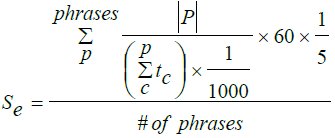
| (3) |
where phrases is the phrase set, p is a phrase from the phrase set, c is a character from the phrase, and tc is the character entry time (ms) from eq. 1. "1/1000" is seconds per millisecond, and "# of phrases" is the number of phrases in the set. Using eq. 3 we estimate an entry speed of 18.1 wpm for H4-TEG. This is a respectable speed, although slightly less than the 20+ wpm reported for H4- Writer [13]. Note that this estimate is for the phrase set and may not necessarily generalize to arbitrary English sentences.
3.2 Glove design
To enhance comfort, the glove's construction uses minimal material. The glove has four spandex finger bands and a Velcro wrist strap. Each finger band has a button connected to a colour-tagged wire running to the wrist strap. The index, middle, ring, and pinky fingers are designated red, white, green, and yellow, respectively. See Figure 1. At the wrist strap, the wires are bundled and run to a keyboard-processing unit in a plastic box with a belt clip for easy placement.
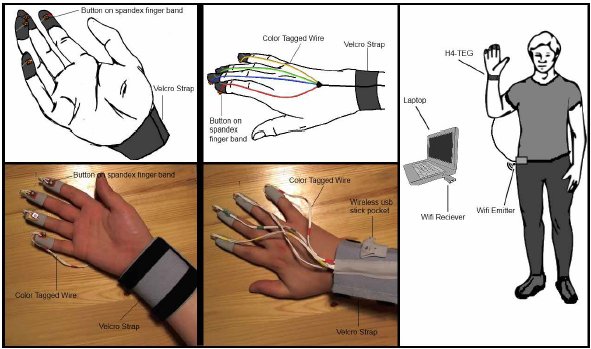
Figure 1. Design sketches and components of H4-TEG.
When fitting H4-TEG for use, the user centres each 3 mm diameter button on the pulpar surface of the distal phalange of the apt finger. When an actuator is triggered through a thumb-distal contact force of at least 1 Newton, the software fires a key pressed event.
Importantly, H4-TEG is untethered. The keyboard-processing unit communicates wirelessly at 2.4 GHz with the computer through a USB adapter, allowing 4.6 meters of freedom. The unit was extracted from a Microsoft Wireless Keyboard 800. See Figure 2.
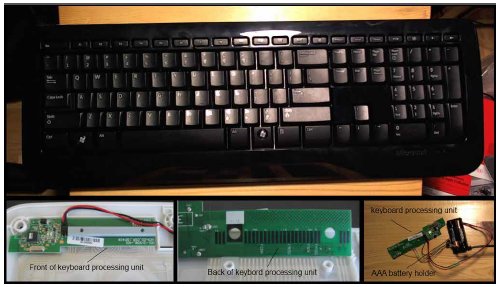
Figure 2. Microsoft Wireless Keyboard 800 and the keyboard-processing unit.
4. Method
To assess the performance of H4-TEG, we employed a methodology similar to the H4- Writer longitudinal study [13]. The goal was to assess learning with visual feedback enabled and performance with visual feedback disabled. A session for comprehensive text entry was also included
4.1 Participants
Six participants (4 male) were recruited from the local university (mean age = 26.5, SD = 4.2). All were right-handed mouse user. Participants were paid $10 per session for 11 one-hour sessions.
4.2. Apparatus
The evaluation used the H4-TEG glove (Figure 1) connected to an Acer Aspire 5741-5869 laptop running Microsoft Windows 7. The original H4- Writer software was used with minor layout and key listener changes to accommodate the new hardware. The interface shows the phrase to be transcribed, the user's transcription, the user's input sequence, and the H4 keyboard. See Figure 3, top. As entry progresses, participants receive visual and audio feedback. With each button press (pinch), the keys are updated to show the characters accessible along each branch in the tree.
Figure 3. H4- Writer software modified for H4-TEG. The Huffman base-4 keyboard is represented by four red boxes. From left to right the boxes correspond to the pinky, ring, middle and index fingers.
The interface sounds a "click" to indicate a key pressed event. The final key press of a Huffman sequence is marked with a "ding" audio cue.
The software logged data for text entry speed (wpm), error rate (%), and keystrokes per character (KSPC). Error rate was calculated using the minimum string distance method [17]. Entry speed is the number of words transcribed per minute based on five characters per word [14].
4.3 Procedure
Each participant engaged in 11 sessions, scheduled over two to three weeks. At most two sessions could take place in a single day (with at least a one-hour break). Only three days could elapse between sessions.
The experimenter briefed each participant on the purpose of the experiment and conducted a brief training session, which included a demonstration of H4-TEG and the H4- Writer software. All participants used their right hand. Participants were allowed one or two warm-up blocks. Warm-up blocks were discarded. Not including the warm-up blocks, each session consisted of 10 blocks with 5 phrases per block. Participants were allowed breaks between phrases and blocks at their discretion. The mean duration of sessions was 78 minutes initially, dropping to 30 minutes by the last session.
Participants sat comfortably in front of the laptop. During the first few sessions they were asked to hold their gloved right hand with the palm facing toward them, so as to align their fingers with the interface. See Figure 4. Later, participants could position their arms any way they pleased. Participants were instructed to relax and to enter text as quickly and accurately as possible, and to correct any errors they noticed as input proceeded.
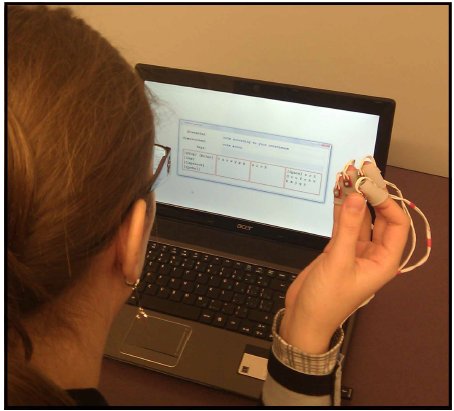
Figure 4. Participant transcribing a text phrase using H4-TEG and the H4 Writer software.
In the event an earlier error was noticed near the end of a phrase, participants were asked to let the error stand. If a participant entered an unintended branch in the H4- Writer code tree, there is no way to exit the branch; instead, they must enter an unintended character followed by BACKSPACE (PP), and then enter the intended character. This particular implementation of error correction was deliberate. Participants were given a device assessment questionnaire at the end.
4.3.1. Part 1: Learning (sessions 1-9). Sessions 1-9 focused on learning. Phrases were drawn at random from a set of 500 phrases [12]. The phrases included only lowercase letters with no punctuation. Participants learned to input the core 26 letters, as well as SPACE, BACKSPACE, and ENTER.
4.3.2. Part 2: Feedback-free (session 10). Session 10 was the same as sessions 1-9 except visual feedback of the Huffman keys was turned off. Participants could only see the phrase to transcribe and their own transcription and were told to recall character encodings as best they could. See Figure 3, middle. In the event of a mistake, they were asked to make only one attempt at a correction.
4.3.3. Part 3: Comprehensive input (session 11). Session 11 used a set of 100 phrases that included a mixture of uppercase and lowercase letters, as well as special symbols. See Figure 3, bottom. This session improves external validity of the study by using the H4-TEG in a more comprehensive text entry scenario.
4.4. Design
Session was the independent variable, which allowed us to characterize learning. The dependent variables were entry speed (wpm), error rate (%), and keystrokes per character (KSPC). In all, there were 6 participants × 11 sessions × 10 blocks/session × 5 phrases/block = 3,300 phrases of input.
5. Results and discussion
5.1 Part 1: Learning
Participants started with a mean entry speed of 5.27 wpm (SD = 1.2) for session 1 and finished at 14.0 wpm (SD = 3.1) at session 9, an increase of 165%. Not surprisingly, the effect of session on entry speed was statistically significant (F8,40 = 51.5, p < .0001). Figure 5 shows the progression along with the power law of learning. According to R2, the model explains 98.5% of the variation in observations.
The final observed entry speed was 22.6% less than the 18.1 wpm estimated by our model. A closer look may shed light on the difference.
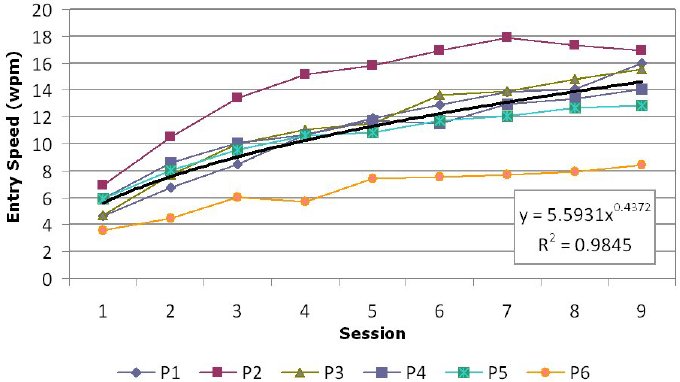
Figure 5. Entry speed (wpm) by session for each participant for part 1 of the study.
In Table 2 we see a comparison between our estimated time for character entry and the observed time at session 9. Overall, it took participants 25.9% longer to input a character than estimated. Perhaps pinching was hindered in some way beyond our assumptions.
| Symbol | Observed Time (ms) | Estimated Time (ms) | Difference (%) |
|---|---|---|---|
| [Space] | 533 | 560 | -5.1% |
| [Bksp] | 678 | 560 | 17.4% |
| e | 587 | 560 | 4.6% |
| t | 585 | 560 | 4.2% |
| a | 828 | 560 | 32.4% |
| o | 838 | 560 | 33.2% |
| i | 705 | 560 | 20.6% |
| n | 797 | 560 | 29.7% |
| s | 700 | 560 | 20.0% |
| h | 783 | 560 | 28.5% |
| r | 983 | 840 | 14.6% |
| l | 895 | 840 | 6.2% |
| d | 1195 | 840 | 29.7% |
| c | 1114 | 840 | 24.6% |
| u | 1328 | 840 | 36.8% |
| f | 1210 | 840 | 30.6% |
| m | 1143 | 840 | 26.5% |
| w | 1022 | 840 | 17.8% |
| y | 1068 | 840 | 21.4% |
| p | 1189 | 840 | 29.3% |
| g | 1157 | 840 | 27.4% |
| b | 1658 | 1120 | 32.4% |
| v | 1620 | 1120 | 30.9% |
| k | 1719 | 1120 | 34.8% |
| x | 2556 | 1400 | 45.2% |
| j | 2170 | 1400 | 35.5% |
| q | 2163 | 1400 | 35.3% |
| z | 1863 | 1400 | 24.9% |
To further examine the discrepancy between observed and estimated entry speeds, we looked at the times for pinch actions. Figure 6 shows pinching times by finger over sessions 1-9. As expected, the difference between fingers was minimal. The ring finger was slowest at 367 ms. The middle and index fingers were fastest at 343 ms. Recall that our model estimated pinching time at 280 ms (large red circle in Figure 6). The observed pinching time was ≈20% longer. Figure 6 also suggests that mental exertion decreases with practice, but that physical exertion imposes a floor effect, about 350 ms per pinch.
Figure 6. Participant finger pinching time over 9 sessions. The estimated time is the large circle at session 9.
Some participants reported slight thumb and palm discomfort after session 6. In this session entry speeds began to plateau. Clearly, participants were becoming adept at inputting text, as seen in Figures 5 and 6. Discomfort was likely due to the motor demand when actuation of small buttons and to the force of actuation. Together with the repetitive nature of the task, it is understandable that entry speeds would plateau, or suffer. It is reasonable to assume then that participants with high hand dexterity would perform better.
Participant #2 reached 17.9 wpm at session 7. This is close to the estimated entry speed of 18.1 wpm. At session 9 this participant had a mean pinching time of 276 ms. Participant #2 likely has high hand dexterity and therefore achieved better performance. Participant #6 performed poorly compared to others. This participant likely had lower hand dexterity, given the average pinching time of 513 ms (SD = 53.2). These cases suggest a hardware improvement for H4-TEG, which we discuss in the future work section.
Over the 9 sessions the mean error rate was low at 0.34%. See Figure 7. It may appear that participant #1 and to a lesser extent participant #4 were outliers. Participant #1 was preoccupied with beating his previous text entry speed and this resulted in a higher error rate whereas participant #4 was just more careless. We included these participants because their mean error rates were <1% overall.
Figure 7. Error rate (%) by session, overall and for each participant for part 1 of the study.
We partitioned the observed KSPC into two parts: KSPC minimum, calculated from the phrases, and KSPC extra, the observed extra keystrokes due to errors and corrections. See Figure 8. The KSPC minimums vary slightly from one session to the next, due to linguistic variation in the phrases. (Phrases were selected at random from the set.) The mean for KSPC extra was 0.257, suggesting an overhead of 1 keystroke every 3.89 keystrokes to correct errors.
Figure 8. KSPC by session for part 1.
5.2 Parts 2 & 3: Feedback-free and comprehensive input
It is interesting to compare the last three sessions of input: session 9 (the last session of Part 1), session 10 (feedback-free, Part 2), and session 11 (comprehensive, Part 3). See Figure 9.
Figure 9. Entry speed (wpm) for sessions 9, 10, and 11. Error bars show ±1 SE.
As noted, the mean entry speed for session 9 was 14.0 wpm (SD = 3.1). Session 10, the feedback-free session, was 3.0% slower with a mean of 13.6 wpm (SD = 4.1). The dip from session 9 to 10 was not statistically significant, as determined in a Scheffé post hoc comparisons test (p > .05). This suggests that participants had memorized most of the Huffman sequences by session 9. In fact some participants, even earlier, appeared to be working through muscle memory for common words and stems such as "the" and "ing". Once again, this enforces the idea that after learning the interface, entry speed was limited mostly by participants' ability to actuate buttons, not the complexity of the interaction.
As expected, with the addition of punctuation and uppercase letters, session 11 was slower than session 9 by 10.8% with mean entry speed of 12.5 wpm (SD = 3.0). Participants were once again able to see the Huffman base-4 keyboard – a necessity, since they needed to visually search for new symbols in the code tree.1 This accounts for the drop in speed.
Figure 10 shows the error rates for sessions 9-11. The average error rates were 0.43% (session 9), 0.76% (session 10), and 0.29% (session 11).
Figure 10. Error rate (%) for sessions 9, 10, and 11. Error bars show ±1 SE.
The increase in error rates for session 10 was understandable, as participants were specifically instructed to only make one correction attempt if they mistyped. If the correction attempt was also invalid, then it can be assumed that the participant did not remember the character encoding.
Conversely, in session 11 error rates were less that those in session 9. With the introduction of new symbols, participants were naturally more careful and once again attentive to the Huffman keyboard.
6. Future Work
The user study demonstrated the feasibility of H4-TEG for text entry in wearable computing. It also highlighted some potential design improvements.
In future work, we plan to employ contact sensors instead of the 3 mm push buttons for each of the four distal fingertips. This design modification will be relatively straightforward, although it requires a fifth wire on the thumb, thereby creating a set of four open circuits. Each pinching motion would close its respective circuit, thereby providing four unique input signals. Thus, the push buttons could be removed, obviating the need for precise, thumb pinching movements and the hypothesized cause of user fatigue.
The questionnaire produced a number of suggestions for UI improvements. During the learning session, some participants wanted the visual display to indicate the depth and ordering of characters in the Huffman tree. This tweak would allow users to learn and prepare for future actions when entering a particular character. Ideally the participant would, at a glance, quickly find the desired letter and, in so doing, have a sense of the number of pinching motions required and which fingers to pinch. This could be implemented using colour, according to the colour tags on fingers (see Figure 1). However, implementing this requires careful design, to avoid confusion.
Another design improvement concerns the nature of the audio feedback. Participants were seen to adopt a rhythm during transcription in synchronizing with the "click" and "ding" sounds of character entry. However, audio feedback may not be practical in some settings. An alternative is tactile feedback. For instance, a tiny motor mounted on the thumb could indicate within-sequence entries, whereas a motor on the wrist strap could indicate final entry. To implement this, however, the wireless connection, presently unidirectional, must support bi-directional communication so that the base system can control the tactile feedback.
7. Conclusion
We presented the design and evaluation of Huffman base-4 Text Entry Glove (H4-TEG), a text entry device that uses the H4-Writer software and finger-thumb pinching motions as discrete inputs. We observed entry speeds of 14.0 wpm after 9 sessions of practice each taking ≈37 minutes. Not only did the H4-TEG achieve speeds close to those seen in chording glove (16.5 wpm) but it also took less time to learn and required more (although simpler) actions to perform character entry. Over all, error rates were <1%, which we attribute in part to muscle memory. Entry speeds were lower than expected, based on a model for pinching times. We hope that with improvements to the design of the glove, entry speeds will increase and physical exertion will decrease.
8. References
| [1] | An, S., Jeon, J., Lee, S., Choi, H., and Choi,
H.-G., A pair of wireless
braille-based chording gloves. Computers Helping People
with Special Needs, Berlin:
Springer, 2004, 490-497.
https://doi.org/10.1007/978-3-540-27817-7_72
|
| [2] | Bowman, D. A., Wingrave, C., Campbell, J. M.,
and Ly, V. Q., Using Pinch
Gloves™ for both natural and abstract interaction
techniques in virtual environments,
TR-01-23, Computer Science, Virginia Tech, Blacksburg,
VA, 2002.
https://doi.org/10.1007/s100550200013
|
| [3] | Bowman, D. A., Ly, V. Q., and Campbell, J. M.,
Pinch keyboard: Natural text
input for immersive virtual environments, TR-01-15,
Computer Science, Virginia Tech,
Blacksburg, VA, 2001.
https://people.cs.vt.edu/~bowman/papers/pinch_keyboard.pdf
|
| [4] | Bowman, D. A., Rhoton, C. J., and Pinho, M. S.,
Text input techniques for
immersive virtual environments: An empirical comparison,
Proceedings of the Human
Factors and Ergonomics Society Annual Meeting, Santa
Monica, CA: HFES, 2002,
2154-2158.
https://doi.org/10.1177/154193120204602611
|
| [5] | Bowman, D. A., Wingrave, C. A., Campbell, J. M.,
Ly, V. Q., and Rhoton, C. J.,
Novel uses of Pinch Gloves™ for virtual environment
interaction techniques, Virtual
Reality, 6, 2002, 122-129.
https://doi.org/10.1007/s100550200013
|
| [6] | Cole, K. J. and Abbs, J. H., Coordination of
three-joint digit movements for
rapid finger-thumb grasp, Journal of Neurophysiology,
55, 1986, 1407-1423.
https://doi.org/10.1152/jn.1986.55.6.1407
|
| [7] | Lee, S., Hong, S. H., and Jeon, J. W., Designing
a universal keyboard using
chording gloves, Proceedings of the 2003 Conference on
Universal Usability - CUU 2003,
New York: ACM, 2003, 142-147.
https://doi.org/10.1145/960201.957230
|
| [8] | Lenhart, A., Teens, cell phones and texting:
Text messaging becomes
centerpiece communication. Washington, DC: Pew Research
Center, 2010.
|
| [9] | Lyons, K., Plaisted, D., and Starner, T., Expert
chording text entry on the
Twiddler one-handed keyboard, Eighth International
Symposium on Wearable Computers -
ISWC 2004, New York: IEEE, 2004, 94-101.
https://doi.org/10.1109/ISWC.2004.19
|
| [10] | Lyons, K., Starner, T., Plaisted, D., Fusia, J.,
Lyons, A., Drew, A., and
Looney, E. W., Twiddler typing: One-handed chording text
entry for mobile phones,
Proceedings of the ACM SIGCHI Conference on Human
Factors in Computing Systems - CHI
2004, New York: ACM, 2004, 671-678.
https://doi.org/10.1145/985692.985777
|
| [11] | MacKenzie, I. S., KSPC (keystrokes per
character) as a characteristic of text
entry techniques. Proceedings of the Fourth
International Symposium on Human Computer
Interaction with Mobile Devices - MobileHCI 2002,
Berlin: Springer, 2002, 195-210.
https://doi.org/10.1007/3-540-45756-9_16
|
| [12] | MacKenzie, I. S. and Soukoreff, R. W., Phrase
sets for evaluating text entry
techniques. Extended Abstracts of the ACM SIGCHI
Conference on Human Factors in
Computing Systems - CHI 2004, New York: ACM, 2004,
754-755.
https://doi.org/10.1145/765891.765971
|
| [13] | MacKenzie, I. S., Soukoreff, R. W., and Helga,
J., 1 thumb, 4 buttons, 20
words per minute: Design and evaluation of H4 Writer.
Proceedings of the ACM Symposium
on User Interface Software and Technology - UIST 2011,
New York: ACM, 2011, 471-480.
https://doi.org/10.1145/2047196.2047258
|
| [14] | Wobbrock, J. Measures
of text entry performance, in
Text Entry Systems: Mobility, Accessibility,
Universality, (I. S. MacKenzie and K.
Tanaka-Ishii, Eds.). San Francisco: Morgan Kaufmann,
2007, 47-74.
|
| [15] | Myung-Chul, C., Kwang-Hyun, P., Soon-Hyuk, H.,
Jae Wook, J., Sung Il, L.,
Hyuckyeol, C., and Hoo-Gon, C., A pair of Braille-based
chord gloves. Sixth
International Symposium on Wearable Computers
Proceedings - ISWC 2002, New York: IEEE,
2002, 154-155.
https://doi.org/10.1109/ISWC.2002.1167238
|
| [16] | Rosenberg, R. and Slater, M., The chording
glove: A glove-based text input
device. IEEE Transactions on Systems, Man, and
Cybernetics, 29, 1999, 186-191.
https://doi.org/10.1109/5326.760563
|
| [17] | Soukoreff, R. W. and MacKenzie, I. S., Metrics
for text entry research: An
evaluation of MSD and KSPC, and a new unified
error metric. Proceedings of the ACM
SIGCHI Conference on Human Factors in Computing Systems
- CHI 2003, New York: ACM,
2003, 113-120.
https://doi.org/10.1145/642611.642632
|
| [18] | Toni, I., Krams, M., Turner, R., and Passingham,
R. E., The time course of
changes during motor sequence learning: A whole-brain
fMRI Study, NeuroImage, 8, 1998,
50-61.
https://doi.org/10.1006/nimg.1998.0349
|
| [19] | Witt, H. and Janssen, T., Comparing two methods
for gesture based short text
input using chording. Extended Abstracts of the ACM
SIGCHI Conference on Human Factors
in Computing Systems - CHI 2007, New York: ACM, 2007,
2759-2764.
https://doi.org/10.1145/1240866.1241075
|
Footnotes
1. Additional symbols begin with the [Symbol] code, PII. See Table 1. Note that the Huffman algorithm was only used for the core symbols, a-z and SPACE. Other symbols were manually added to the code tree, as described in the design of H4- Writer [13].
